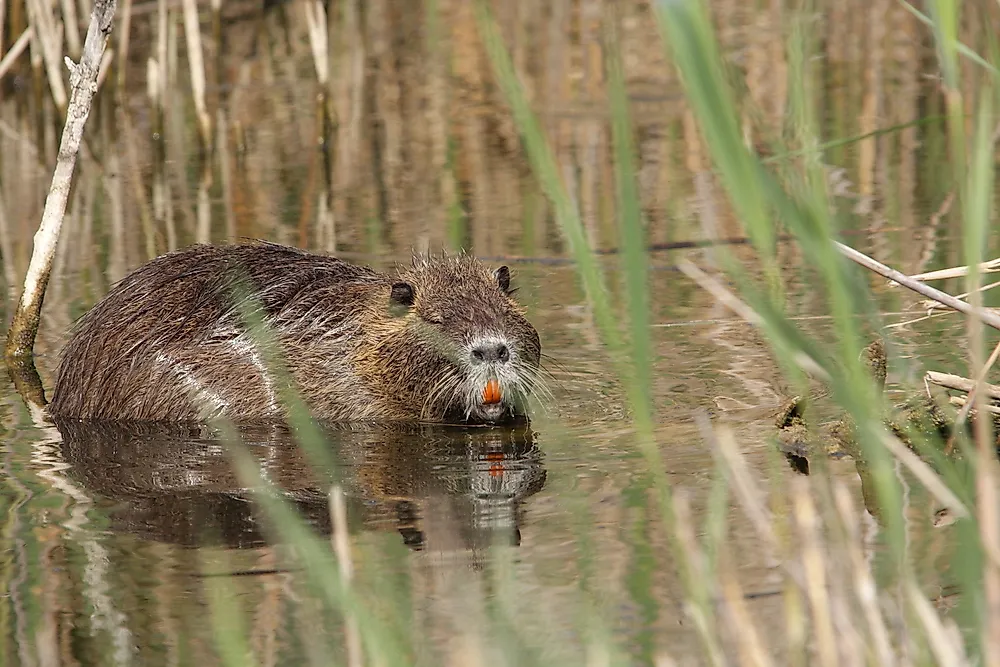Nutria Rats - Animals of the World

In South America, this large rodent is known as a coypu, but in the US it is known as the nutria rat. Its genus, Myocastor, comes from the Greek words "Mus" and "kastor" meaning "rat" and "beaver". Myocastor literally means "beaver rat". In the US, the nutria rat is known as an invasive species. The nutria rat is native to South America, but was introduced into the wetlands of the southern US during the 20th century. The feeding habits of the nutria rat have caused destruction to wetlands in the USA.
4. Behavior
Nutria rats are known for their ability to live in captivity. The nutria rat is known to live up to 6 years in a state of captivity. A female nutria rat has the potential to give birth to as many of 13 nutria rats. The gestation period of a nutria rat is around 4 months. There is also the potential for a female nutria rat to be pregnant three times in one year. A newborn nutria rat can eat vegetation alongside its parents within hours of being born. This is due to the nutria rat being precocial, meaning that it matures rapidly. However, its mother will still nurse it. A baby nutria rat will leave its mother two months after birth.
3. Habitat and Range
Nutria rats are semi-aquatic animals. They can live on land, but can be found in water. The most common place to find nutria rats are in freshwater marshes. Freshwater marshes are the type of habitat that nutria rats find their main source of food. Nutria rats will also inhabit brackish marshes. These are marshes where salt water and freshwater mix. It is rare to find nutria rats in salt water marshes. The nutria rat is native to Argentina, Chile, Brazil, Paraguay, and Uruguay. Also known as the coypu, this is where it can still be found today. However, it is also found in North America, especially in the wetlands of the southern US. It is here where the nutria rat has become an invasive species. This rodent was brought to the US for the purpose of breeding for the fur industry. In the state of Louisiana, many nutria rats either escaped from enclosures or were released into the wild. The nutria rat had no natural enemies and the wetlands of Louisiana provided the vegetation for its diet. Because nutria rats can eat large amounts of vegetation, this causes widespread devastation to wetlands in Louisiana. This is why the nutria rat are classified as an invasive species in North America.
2. Diet
The nutria rat is an herbivore. Plant stems make up a large part of the rodent's diet. Nutria rats will also eat the rhizomes and roots of plants. Being a big rodent, large amounts of plant material are consumed by nutria rats. On a daily basis, a nutria rat will eat up to 1/4 of its body weight in vegetation. The average nutria rat at adulthood can weigh between 10 to 20 pounds depending on gender. This adds up to 2.5 to 5 pounds worth of vegetation daily. Nutria rats prefer the roots and rhizomes of plants due to their succulence. In the winter, when green plants are not as widely available, the roots and rhizomes of plants are very important for a nutria rat's diet. In many cases, nutria rats will dig up an entire plant to reach the roots and rhizomes. Nutria rats will also eat crops and grass from lawns. This often takes place in areas where people are living very close to wetland areas.
1. Physical Description
The nutria rat has a resemblance to a large rat or beaver. One major distinguishing trait is its orange front teeth. It has a brown coat with a white patch on its muzzle. Nutria rats also have webbed hind feet. Nutria rats have often been mistaken for other rodents. Particularly, it is often mistaken for beavers and muskrats. Nutria rats are larger than muskrats and have round tails. Beavers have flatter tails than nutria rats as well. From the base of its tail to its muzzle, an adult nutria rat will have an average length of 2 feet. The tail of an adult nutria rat will vary between 1 foot to 1.25 feet. Male nutria rats will generally be larger than female nutria rats by weight. The average male nutria rat will weigh between 12 to 20 pounds. A female nutria rat will vary in weight between 10 and 18 pounds.











